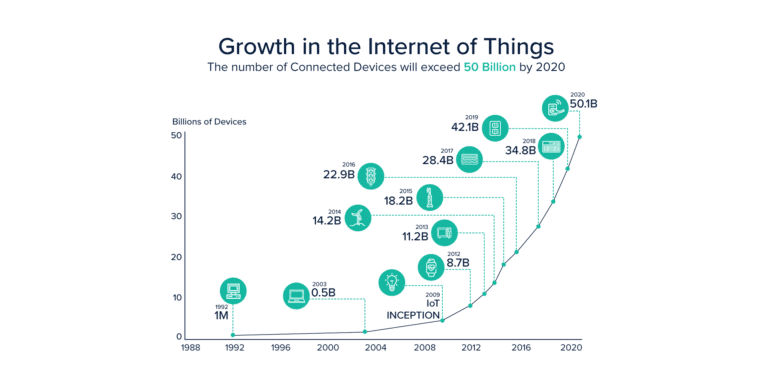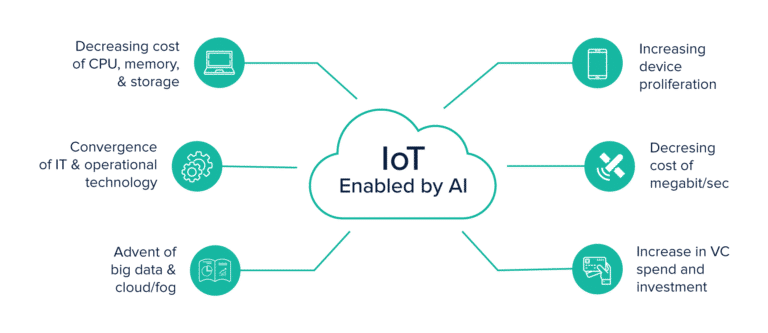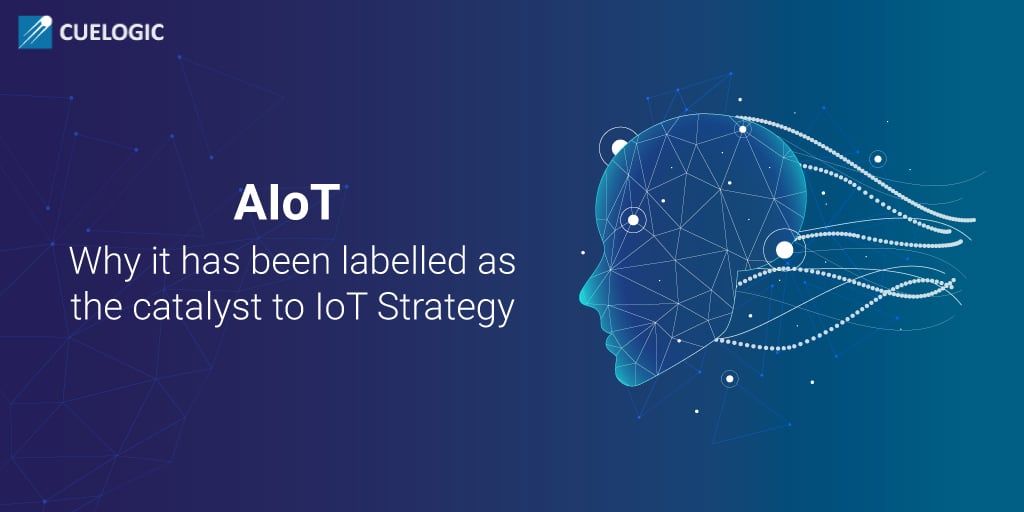Artificial Intelligence (AI) and the Internet of Things (IoT) have long worked as independent cogs of diverse IT systems. But there has always been an inherent bond between them.

While AI is often looked at as the brain of a network, IoT essentially functions as the digital nervous system. In this blog, we take a close look at ’What is AIoT’. We will then understand how AI and IoT are related and how they work cohesively to create immense value for organizations, no matter the industry.
Evolution of IoT into AIoT
IoT is getting smarter as we speak. It is practically everywhere, from home automation systems and nanobots in manufacturing to self-driving cars and heavy machinery. The growth has been so profound that by 2020, the industry is set to witness 50 billion+ connected devices.

As you may already know, IoT connects a vast array of portable devices, home appliances, wearables, and other electronics/machines over a network. Connected devices can signal their environment and be remotely monitored, controlled, and maintained. While all this works well on paper, there is a catch (and a rather obvious one). Round the clock monitoring naturally leads to a never-ending influx of complex data. For instance, a car manufacturing company may want to monitor everything from tire pressure to fuel performance in order to push the boundaries of future models.
Harnessing IoT data into actual business value is a huge task, especially since the usage of the device is dependent on the habits of end-users. Even heavy machines may not perform identically due to varying environmental conditions. No two use-cases are the same, calling for extensive personalization capabilities.
When AI Meets IoT – What Is AIoT?
This is exactly where AI comes into the picture.

Artificial Intelligence thrives on data. It is all about learning and automation by using a range of statistical and computational techniques.
When embedded with AI, IoT devices get additional capabilities such as learning from user interactions, service providers, and even other devices in the ecosystem. They can better adjust to new inputs or changes in the environment and accomplish niche tasks, all without any manual intervention.
To put the need for this in perspective, a connected vehicle can generate around 25GB of data per hour. In fact, autonomous vehicles can go to as much as 1GB per second. Without AI-driven computations, such massive data influx would be completely obsolete.
How Does AIoT Differ From IoT
Traditionally, IoT devices were all about collecting data. The idea was to create an intricate mesh of connected devices that constantly relay critical network information to admins.
On the other hand, AIoT goes beyond such a role, analyzing data patterns, and providing all information that you need to make the best decisions. In certain cases, it can even make the decisions itself, saving countless computations hours and enhancing the capabilities of the network.
In practice, this translates to automated identification of patterns and detection of anomalies in the data that is generated by smart sensors. For instance, a self-driving car can collect and analyze information related to temperature, pressure, humidity, air quality, and more.
But why is this better than IoT? Traditional business intelligence has long been dependent on numeric thresholds, making predictions reactive in nature. With AIoT, accurate operational predictions can be made up to 20 times earlier.
Benefits of Artificial Intelligence of Things (AIoT)
As evident, AIoT is paving the way for a mature ecosystem, one that delivers more value for organizations and end-users alike.

Benefits of AIoT for Businesses
By capturing real-time data and analyzing it, businesses are leveraging AIoT to create real value:
- True automation of manual tasks, with the system able to make autonomous decisions, boosting productivity and efficiency.
- Optimization of processes to the point of reduction in marginal transactional costs.
- Faster lifecycle of conversion of data into tangible business value.
- Easier implementation and growth of business operations with focused insights and quicker decisions.
- Better customer management and communication with advanced bots and speech recognition.
- Constant experimentation and iterations of products and accompanying services.
- Quicker time to markets of product updates or new releases.
Benefits of AIoT for Customers
A natural after-effect of a well-functioning business is that the benefits are ultimately passed on to the customers. Here’s everything that AIoT brings on the table in this regard:
- With deeper insights and data analytics, customers receive a much better product experience.
- By taking into account behavioral patterns and personal preferences, personalization becomes key.
- Critical-value health products such as wearables that monitor vitals can function with significantly improved efficiency, enhancing customer experience.
- Better overall product performance and quicker access to better versions.
- Predictive learning capabilities that train algorithms to executive redundant user-end tasks, such as ordering for refills or monitoring system health.
Keys to Success with AI and IoT
For an organization that is planning to invest in AIoT, the following implementation blueprint works well for a successful deployment.

Real-Time Analytics
Analyzing diverse data sets by using event stream processing and identifying the most relevant incidents. A crucial ingredient to analyze any data in motion. This plays a major role in:
- Constantly monitoring aggregated information from sensors and finding correlations or trends that might be indicative of possible system failures. This empowers devices to be smart enough to make autonomous decisions such as sending notifications or shutting down systems.
- Using predictive analysis to optimize operations in real-time and make on the spot decisions. These can also be based on other input variables on which the result is dependent.
- Detecting critical events by analyzing complex patterns in real-time. This can keep an eye on unusual device activities related to banking transactions or detection of threats.
- Validating and handling data received from sensors. This ensures that any delay in data relay is handled with care and relevant data patterns in data streams can be detected.
Leveraging Application Analytics
Depending on the use case of the technology, deploying analytics as per specific purposes. The implementation strategy for analytics can be accordingly selected and applied in different scenarios. Sometimes the data might need to be analyzed on the spot, while other cases might call for permanent storage. Use-cases here typically include:
- High-performance analytics for extensive data sets at rest.
- Edge computing to analyze data in real-time and at the source.
- Streaming analytics to analyze diverse data sets that are in motion.
Merging of AI
For AIoT to succeed, AI can no longer be deployed in isolation. It needs to work closely with Machine Learning, Natural Language Processing, and Computer Vision to be of any real value. Examples of use cases here may include:
- Research clinics leveraging large volumes of diagnostic data sets to provide guidance to physicians.
- Using deep learning and neural networks to analyze visual imagery.
- Building comprehensive patient/customer/client profiles based on medical history (such as pacemaker data) or engagement patterns with products.
Unification of Lifecycle
To be successful at scale, AIoT needs complete access to every possible data set before cleansing it for deeper insights. This means linking the entire analytics lifecycle with phases such as:
- Data analysis at high volumes, high rates, and low latencies through event stream processing. This can filter out any events of interest-based on the set parameters.
- Real-time data streaming of all events of interest that are required to make decisions. The recommendation engine analyzes such data sets and takes the most relevant action.
- Big data analytics in distributed computing environments with increased accuracy. This is an important prerequisite to quickly devour massive data sets and churn out critical insights.
- Analytical model management that tracks evolution and performance levels across entire life cycles of analytical models. This maintains that the performance does not degrade over time.
The Way Forward
AI and IoT are together solving a problem that has existed since the inception of the latter – managing real-time data received from numerous connected devices at once. This is making an entirely new generation of IoT devices possible.
Cuelogic has been at the forefront of this revolution, helping organizations navigate through the complexities of the trade and making their IoT devices future-proof.
For more information on how to truly unlock the potential of connected things, simply share your details with us for a detailed consultation session.
